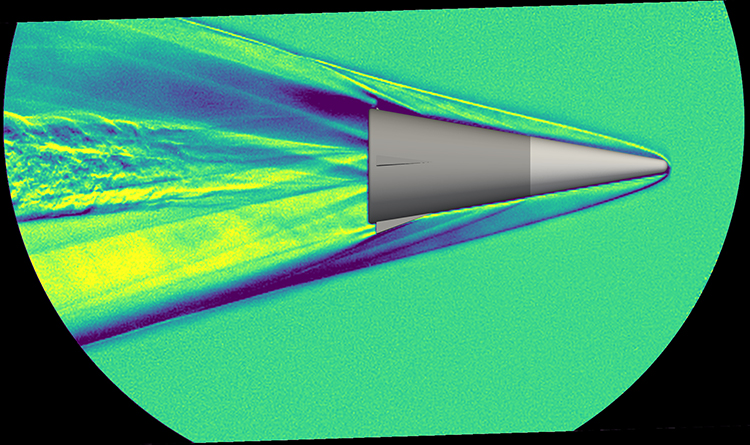Background
Traditional aerodynamic and aerothermal testing is conducted in ground test facilities, such as hypersonic wind tunnels or on high-speed sled test tracks. Every ground test facility performs design trade-offs to achieve hypersonic flight conditions on the ground. Most wind tunnel facilities sacrifice the acoustic and chemical environment to achieve hypersonic air speeds. Ballistic launch facilities, which are far fewer in number, retain control over the environment being flown through, but can no longer hold a test article fixed in space. While such tests more faithfully recreate the high temperature dynamics of hypersonic flight, it makes diagnostics and measurements extremely difficult.
Approach
This program focused on the development of laser-based optical diagnostics to observe flow fields around ballistic test articles in free flight. Experiments were designed to have laser light interact with materials being shed off the surface of the test articles in flight. Projectiles were surface coated with different chemicals, such as solvents, ketones, and high molecular mass hydrocarbons, that interacted with either ultraviolet or green laser light. The experiments used a high-powered pulse burst laser system (from UTSA) in SwRI’s two-stage light gas gun facility. SwRI and UTSA researchers tried multiple configurations of the laser system, varying laser wavelength, power, optical configuration, dye tracer application, projectile design, and launch package design.
Accomplishments
This program performed the first known proof-of-concept tests using laser-induced fluorescence (LIF) diagnostics to observe the flow field around an object traveling at hypersonic speeds. These experiments combined SwRI test facilities with UTSA diagnostic equipment and were the first known LIF tests in any LGG facility for ballistic tests. Ultimately, LIF of chemical tracers was not achieved using more volatile solvents (acetone, toluene, pentanone); however, the use of less volatile hydrocarbons as a LIF tracer, such as trimethylbenzeindole, was successfully demonstrated. The use of tracer particles (aluminum flake doped trimethylbenzeindole) was also demonstrated to be a successful flow-field marker. However, its use may be restricted to evaluating wake flow dynamics due to significant laser light scattering when the projectile is in the laser sheet.

Figure 1: Schlieren image from high-speed video showing conical projectile traveling left-to-right at Mach 5.4 and the shock wave structure around the object in free flight. Experimental image false-colored to show detail and CAD image of test article embedded in image for illustration.

Figure 2: Color high-speed video camera showing projectile after having passed through the laser sheet. Material being shed from the projectile entrained in the wave is illuminated by the laser sheet.
